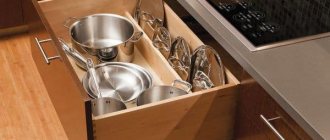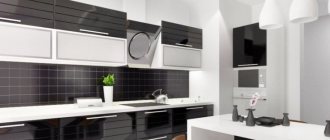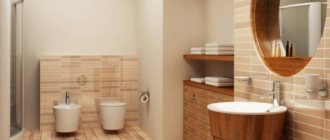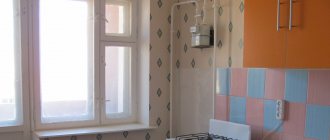What is railing?
A kitchen rail is a metal strip or pipe that is used to store kitchen utensils and food. Depending on the type of fastening, they can be of several types: • Horizontal – mounted on the wall between the upper, wall, and lower cabinets. Today, this is the most popular type, since thanks to this method, ladles, napkins, oven mitts and coasters for hot dishes are always at hand. • Vertical – connect the wall shelf to the table top, or to the floor. They are a little less common, as they take up a little more space, because they do not have hooks, but only special shelves. • Suspended – usually attached to the ceiling. Such roof rails can often be found in various culinary programs. They are used primarily for storing pots, saucepans and frying pans, but they can also be used to store decorative items, such as wicker baskets or bunches of garlic.
Horizontal rails can be: Multi-tiered - short rails that hang one under the other are convenient if you do not have upper wall cabinets. Single-tier - one long pipe that is attached along the entire working surface, the most common form of railing system. Takes up minimal space.
In the photo there are shelves for railing in the kitchen
Not fashionable
About 10 years ago, rails were in almost every kitchen. Times change, and minimalism and asceticism came into fashion a long time ago, so this idea is no longer relevant.
It is best to replace them with several practical and convenient shelves. You can place everything in them without any problems, and the space will be much larger. They will suit you only if you like it when everything is in sight and before your eyes.
You can consult with designers or independently find on the Internet something that can replace this idea.
What are the roof rails made of and what colors do they come in?
This wonderful kitchen accessory is made mainly of steel and has 4 main colors: • steel • copper • gold • bronze. The most common, of course, is ordinary steel (can be matte or chrome-plated), as it looks most harmonious in a modern kitchen. If you have a stylized kitchen, for example, in Provencal or English style, then the color “bronze” will fit perfectly into such a kitchen.
Gold or copper will be an excellent addition to a kitchen made of solid wood and having gold or bronze embossing on the facades.
If a simply made of steel and painted roof rail does not suit you, and your kitchen is designed in the now fashionable high-tech style, you can order an unusual roof rail with lighting, but it will cost much more than usual. For example, if 120 centimeters of a simple pipe costs from 150 to 300 rubles, then the price of a backlit roof rail starts from 1,000 rubles, and the price for a set (backlit roof rail and touch switch) will already be 10,000 rubles. Some manufacturers offer wooden roof rails. But they have more of a decorative function than a practical one. After all, wood cannot withstand frequent exposure to water and temperature changes. In the kitchen, such a roof rail will very quickly lose its attractive appearance (it will darken, dry out and crack).
How to choose roof rails
Here are some tips on how to organize an effective storage system.
Tip 1. Create a unified style
The fittings will harmoniously complement the interior if the color and design of the accessories are chosen correctly. Let hanging items, furniture handles, finishing elements and parts of household appliances be decorated in the same color scheme.
- Railings with gold or bronze plating will transform kitchens in a classic or retro style. The presence of carved holders will be a plus.
- Simple crossbars made of chromed metal will emphasize the laconic character of Scandi, hi-tech and techno styles.
- Rails made of matte or antique gold, copper, brass, bronze, matte silver will become full-fledged style elements in country and Provence interiors. Decorate hanging glasses with lavender bouquets, arrange jars of spices, hang checkered napkins on hooks, and your kitchen will be filled with the atmosphere of France.
- Black or bronze rods will fit perfectly into loft and industrial spaces.
Tip 2. Choose the right type of roof rails
Horizontal - the usual crossbars. They are usually mounted above the work area - above the countertop, stove, sink. For convenience, hang the rails at a height of 50cm, and not too close to the hanging cabinets. To make the most of space, such rails are also placed at the ends of furniture, in wall niches, on doors and under hanging shelves.
Vertical - used in kitchens with bar counters. They are also simply attached to the tabletop or stretched between the floor and ceiling.
Hanging – more often found in island kitchens (when the work area is located in the center of the room). Such roof rails are suspended directly from the ceiling.
Tip 3. Determine the quantity
On the roof rails you will place items that you use every day. As a rule, their number is limited. Therefore, you should not overload the space with numerous details. 3 rails 60 cm long are a convenient and functional maximum for standard kitchens.
Tip 4. Calculate the load
The fastenings on the crossbars should be located every 50 cm from each other. To ensure that one system can withstand several elements at once, choose rods with a diameter greater than 40 mm. And the railing, which you plan to load well, is better to hang on the wall, and not on the end of the hanging cabinet.
Tip 5. Size matters
Consider the features of your kitchen to choose the most suitable railing.
- In small rooms, it is not entirely appropriate to place your entire collection of kitchen utensils on rails. Leave only the essentials, otherwise you risk getting a disorderly pile of items.
- And if the kitchen is spacious, then one long rail, fixed under the hanging shelves, can completely free up the work surface.
- A corner shelf for sponges, washcloths and dishwashing detergents will allow you to make the most of the space above the corner sink.
- A narrow wall can be equipped with a system of multi-level railings.
Tip 6. Decide on hanging accessories right away
In addition to the roof rails themselves, you will also need hanging elements with which you can create individual storage systems. You will need:
- S-hooks
- shelves, different sizes, configurations and purposes
- baskets and glasses not only for storing cutlery, but also for growing fresh herbs for the table
- drying racks for dishes and appliances
- holders for towels and rolls
- spice jars
- shelves for glasses and bottles
Look at the full catalog of our company's products and choose what you need. A well-built system will make the kitchen a favorite place for all family members.
- Starting your day with coffee? A small two- or three-tier railing will help keep mugs, spices, and filters near the coffee machine.
- Are you used to making cocktails at home? Place a shelf with wine glasses above the bar counter.
- Amazing your family with a varied menu? Organize a convenient space for yourself: a knife holder, shelves for spices, pots of herbs.
Tip 7. Where to buy a railing system for the kitchen
The kitchen is the soul of our home: here the magic of turning food into delicious dishes begins, here we gather with the whole family, we drop in here to be alone with a cup of aromatic tea and with our thoughts. This is a special space. Therefore, all the details here must be special - high-quality, reliable, aesthetically attractive.
It is these qualities of roof rails that we recommend paying attention to when purchasing. Lemax products meet all the necessary criteria: a harmonious combination of aesthetics and functionality, comfortable everyday use and reliability in every detail.
Railing is an accessory that will find its application in any kitchen. And correctly selected elements of the storage system become not only a practical, but also an aesthetic solution for organizing space.
Lemax roof rails – No. 1 choice of professionals *
According to the results of a comprehensive study conducted by Factory of Marketing, the Lemax brand confirmed its high position in the kitchen railing market.
More than 50 companies professionally involved in furnishing kitchens took part in a survey in which respondents were asked to answer a series of expert questions characterizing the brand. This study showed the following results:
- Adequate prices and high quality of Lemax products are the main criteria for choosing specialists.
- Given a fairly saturated and competitive market, professionals prefer the Lemax brand, characterizing it as a stable and reliable partner.
- In voting for the most attractive slogan for the Lemax brand, the majority of respondents preferred the slogan “Professionals' No. 1 Choice.”
What can be stored on the roof rails?
The main advantage of this method of storing things is that everything you need is always at hand, but does not occupy the working surface of the table. There are a huge number of related products for roof rails. These include hooks, shelves, and various glasses and coasters. Everything is clear with hooks: skimmers, towels, cutting boards, pastry brushes, etc. are hung on them. But with the choice of shelves it turns out to be more and more difficult, since you have to decide what exactly from the whole variety to buy, and which shelves will suit your kitchen. Rectangular shelves, square, corner radius... Each of them is functional in its own way, but you should know when to stop and not overload the railing with unnecessary details. It is best to limit yourself to one or two shelves, ten hooks and a metal stand for pots and pans.
Pictured is a kitchen rail
What and why is it needed?
What do we use most in the kitchen? •Detergents. •Poven mitts. •Salt and spices. •Cutting boards. • Ladles, spatulas. This is what the list of things that should always be at hand looks like. Therefore, it makes sense to place towels on hooks, and detergents on a hanging shelf next to the sink, spatulas for cooking and special hanging containers for spices can be placed near the stove. Cutting boards can be stored on hooks, but you can also purchase a special shelf for them. A special metal hot stand will make life and cooking much easier. Thanks to it, your countertop will always be safe (often the film that covers the countertops cannot withstand the temperature of the dishes removed from the stove) and storing such a stand is also very convenient: it has special handles and clings directly to the railing.
What types of shelves are there for kitchen railings?
When choosing shelves, you should consider what you will store on them. Most suppliers offer a separate shelf for each specific item. So, you can order a holder for foil, a holder for paper towels, jars for spices, the lids of which are already hooks for attaching to the railing. Thus, the simplest rectangular or radius shelves can be useful for placing detergents or some decorative elements on them, for example, a small flower in a pot or a beautiful candlestick. If you have a vertical rail with a hanging shelf, then you can buy a shelf-holder for glasses (glass holder), a round shelf on which you can store fruits or bread.
Installing a roof rail in the kitchen
If you order a new kitchen set, then there will be absolutely no problems installing the railing. The master who will install your furniture will also install the railing system. However, if you buy it yourself and want to install such a system yourself, then there should be no problems either. All you need is: 1.Building level. 2. Drill. 3. Hex key. Using a level, we make markings for the fastening.
The railing should be mounted at chest level, then it will be convenient for you to remove and hang up everything you need.
After the markings have been made, use a drill to drill holes for the dowels, then insert a self-tapping screw into the sleeve and screw it into the hole with the dowel. All supports for the railing system are secured in the same way. But you should remember that if you install a long railing, then the number of supports per 1 meter of railing should be at least 3 pieces. As can be seen from the article, the railing system for storing dishes and food in the kitchen is not only convenient, stylish and relevant, but also very easy to install and use. Modern stores are ready to offer housewives a huge number of design options for such a system: horizontal (single- and two-tier), vertical, with mounting to the ceiling. The variety of colors is also impressive: stainless steel, chrome-plated, stylized gold, or copper. And convenient and stylish accessories that perfectly complement this system will not only give your kitchen a unique charm, but will also save time and free up space.
Drilling holes for installing roof rails
As a rule, kitchen walls are finished with tiles, which are laid on a concrete base. In this regard, drilling holes for the railing holders must be done with a special drill with a Pobedit tip or diamond coating using an electric drill or hammer drill.
Railing mounting diagram.
After the final marking of the mounting points for the railing supports, “crosses” with a side length of 5-6 mm are applied on the surface of the tile at the drilling points using a diamond glass cutter. In this case, when drilling, the tile will not crack, the hole will be located at the required point.
To install a railing of small thickness with a relatively low mechanical load on it, you can use a drill with a diameter of 5 mm to drill holes. If it is necessary to provide large loads, it is necessary to use drills with a diameter of 8 mm or more. The depth of the holes is determined by the length of the mounting screws and the length of the plastic inserts into which the mounting screws will be screwed.
After the holes for attaching the railing posts are drilled, standard plastic plugs are inserted into them, the length of which corresponds to the length of the mounting screws. With their help it is necessary to secure the supports. Using self-tapping screws, intermediate fastening pins are secured to the ceiling, room walls or furniture walls according to the markings (for fastening load-bearing racks).
Care must be taken to ensure that the screws are tightened all the way and that the supporting pins are installed without any backlash or distortion.
The railing posts are placed on the supporting pins and secured to them using shaped screws. When installing, make sure that the screw heads are not visible. For example, on a horizontal rail they should be located at the bottom of the post, and on a vertical rail they should be located either on the top or bottom side of the posts (depending on the height of the mounting points).
Choice of roof rail color
Manufacturers offer us a large selection of colors: old gold, brass, bronze, copper. But the most popular colors are nickel, chrome and anodized aluminum. When choosing a color, professionals advise basing your choice on the design of your kitchen appliances.
Accessories for railing
There is a huge amount of additional accessories for the railing system. The main one is an S-shaped hook, on which kitchen tools cling. Moreover, with the correct placement of the railing, sometimes there is no need for upper cabinets.
Within walking distance of you, there is a service for calculating cabinet furniture.
How to install a kitchen rail
Every woman dreams of having a railing system in the kitchen. Therefore, you will make a good gift by installing this accessory for her yourself. Moreover, there will not be any special difficulties. You will need a hammer drill, a level, a hacksaw and a Phillips screwdriver.
The kit includes a main chrome bushing that holds the rack. A sleeve with a groove that is attached to the wall with a self-tapping screw and then the main one is mounted on it. Two black mounting bolts, a self-tapping screw, a hexagon and a dowel.
Insert the self-tapping screw into the mounting sleeve. I recommend immediately replacing the dowel with a more reliable one so that there are no problems in the future. We tighten the black mounting bolts into the main chrome bushing. Where one bolt will hold the bushing, and the second the rail.
Accessories for railing systems
The main difficulty when planning a railing system is the choice of accessories. They should be selected in such a way as to ensure convenient storage of cutlery, but without making their arrangement disorderly.
Today there are more than 300 different devices designed for hanging on pipes. The most popular are hooks on which you can hang skimmers, ladles, mashed potatoes and other items. Various shelves equipped with built-in hooks are used to place spice jars, bottles or glasses. They can be round or square, consist of one or two shelves. In addition, consumers should pay attention to the following accessories:
- dryers for plates and fruits, which are usually located above the sink;
- holders for glasses, knives, paper towels;
- bread bins;
- coasters for kitchen boards, pot lids, hot dishes;
- holders for rolled items - cling film, parchment, foil.
All these elements can be combined with each other. For example, hooks go well with a glass holder and a shelf for paper towels.
Installing a roof rail in the kitchen: where, how and why it is installed
The kitchen work area, first of all, should be functional and rational - everything should be at hand, otherwise working will be inconvenient and tiring. To achieve such functionality, a person resorts to the help of various things and devices, without the use of which it is even difficult to imagine a modern kitchen. One of these devices is a railing - this is a thin tube mounted on the wall, which allows you to place all the most necessary utilities on it using small devices. It is about this device, or rather about how the roof rails are installed in the kitchen, that we will talk about on this page of the okuhne.net website.
Installing a roof rail in the kitchen photo
Preparing the tools
Installing roof rails in the kitchen will not take more than 30 minutes.
After all, in essence, the railing is a pipe, most often metal, along which hooks, nets, additional shelves and brackets move.
They will hold kitchen accessories and utensils. To ensure the installation process goes quickly and efficiently, you need to prepare the following tools:
- electric drill or screwdriver;
- hammer (preferably two different sizes);
- building level (laser, if available);
- hex key;
- plastic dowels;
- self-tapping screws;
- railing system.
The tools are ready. Now you need to decide at what height to hang the railing in the kitchen. A standard system of one long tube is installed at a height just above chest level (above the tabletop). If the roof rails have a multi-tier system, it is better to install them at eye level.
If you want to place the system under wall cabinets, step back about 8 centimeters from the bottom of the cabinet. Installing a roof rail in a kitchen will involve several processes. No matter how much you would like to hang the holders faster, take your time, because the system must be securely and firmly fixed.
Installing roof railing in the kitchen: its capabilities and types
Before deciding how to install a roof rail in the kitchen, you should solve another question: where to install it? And the answer to this question can be obtained by studying the capabilities of this device and its varieties. There aren’t that many of both, so let’s look at them point by point – let’s start with the capabilities, or rather, with the additional devices that provide these same capabilities. As a rule, the roof rail can be equipped with the following additions.
- Hooks. Quite a lot of them fit on the tube, and they fully allow you to hang quite a lot of stuff on the wall. We will not be specific, since the railing with hooks can be used not only for placing ladles and spatulas, but also for many other things - towels, bags, cutting boards, etc.
- Shelves. As a rule, these are small horizontal lattice platforms that are attached to the railing using hooks - the shelves hang on it and allow you to store all the little things necessary for cooking. Spices at hand are convenient and practical, but, as a rule, the matter is not limited to them. Let me emphasize once again that you can keep anything on such open shelves - however, you should remember that not every kitchen utensil can serve as decoration.
How to hang a roof rail in the kitchen photo
And that's not all the railing devices. The products listed above belong to the category of universal ones - in addition to them, there are also highly specialized devices. For example, a holder for disposable towels, a device for bottles and jars, cutting boards and even stands on which it is convenient to hold your favorite magazine with your favorite culinary creation. You understand that such a variety of devices for railing allows you to install it not in any specific place, but almost everywhere. It is for this reason that modern kitchens are equipped with long rails extending from edge to edge of the worktop with all its twists. In fact, it allows you to use the kitchen apron to its fullest potential and for practical purposes, and not just as decoration. As for the varieties of this product, there are only two of them - single railing and double. In the latter case, this product can be represented in the form of two parallel tubes located above each other and offset with respect to the wall. You understand that the functionality of this railing can be much greater.
Choosing a location and installing a roof rail
The location for installing the railing is selected based on the location of the kitchen furniture, the functional purpose of the individual elements and ease of use. The length of the supporting steel tube of the railing, regardless of the shape and options for its location, is limited only by the size of the room, the required free space and, of course, aesthetic preferences.
The standard length of the railing is 3 m, but if necessary, it can be shortened or extended using special couplings and inserts. The ends of the pipe are closed with decorative plugs to ensure safety of use and give the structure a finished look.
After the initial preliminary marking of the location, determining the length, number and shape of the rails, we install supporting structures, which will be the basis for attaching the pipes to the load-bearing wall, ceiling or furniture walls in the kitchen.
It should be taken into account that the installation step of the railing fastening elements should not exceed 0.5 m, that is, if a pipe 1 meter long is installed, then the number of points for attaching it to the load-bearing surface should be at least 3, 2 at the edges and 1 in the middle parts.
Markings for installing horizontal or vertical railing should be done using a building level or plumb line at the height required for hanging objects. When marking, you should take into account the size and weight of kitchen utensils hung on the railing and, accordingly, additional holders. If you plan to use the railing for massive objects, then the fastening step should be reduced.
Attaching the railing in the kitchen: how it works
First, let's look at the design of this device - this way, at least, it will be easier to understand how it is installed. The railing consists of two main parts.
- The supporting tube, which, in turn, also has two constituent elements - the tube itself and two plugs that not only close the voids of the pipe, but also serve as a kind of limiter that does not allow hooks and other devices to move and thereby fall off the tube . The plug also consists of several parts - it is a plastic plug that is driven inside the tube and serves as a kind of chop for screwing in a self-tapping screw, which, in turn, is rigidly connected to the decorative cap.
How does a kitchen rail work? photo
Despite such a relatively large number of small parts of the railing, installing this device is quite simple - if you exaggerate, you only need to drill a couple of holes in the wall and secure the railing itself in them using self-tapping screws.











